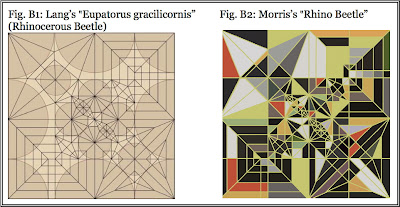 |
| Two of the comparisons attached as Exhibit A to the complaint |
Robert J. Lang, arguably the world's most famous origami artist, and several other co-plaintiffs have filed a complaint in federal court against painter and film maker Sarah Morris alleging her "Origami series" (2007) infringes their copyrighted artworks of crease patterns ["the lines of a crease pattern represent the folds needed to create a three-dimensional origami model from a sheet of paper"]. The complaint states that Morris "transferred crease patterns to canvas and applied household gloss paint to the spaces between the lines. Morris has represented in interviews and promotional materials that the paintings in the Origami series are based on "found origami designs" or "traditional" patterns." Twenty-four of the approximately thirty-seven works comprising the series are said to be "strikingly similar" to the copyrighted crease patterns, which are in no way referenced nor attributed to their original authors. Each of the original artworks was either the subject of a valid Certificate of Copyright Registration or of a pending application for registration, though failure to register an original artwork ("original" in a legal sense) does not preclude copyright protection completely -- it goes to the question of the relief a plaintiff can seek. Except in relation to those rights under §106A(a), to be able to claim statutory damages in the alternative to compensatory damages and attorney's fees, the work the subject of the litigation must have been registered no later than the earlier of 3 months from the date of first publication or 1 month after the copyright owner learnt of the infringement, which explains why the relief sought differs depending on the crease pattern.
The complaint lays out the facts in detail but doesn't state why it is that Sarah Morris' actions allegedly constitute copyright infringement for which the plaintiff is entitled to relief at law. In other words, the complaint doesn't point to the relevant law under which Morris' actions could amount to copyright infringement (most likely because the applicable pleading standard merely requires the plaintiff to put the defendant "on notice" rather than pleading the complaint "with particularity"). However, if you go to Lang's website you will find a brief summary of the main legal argument, this being that the owner of a copyright has exclusive rights under § 106(2) of the Copyright Act (17 U.S.C.) not only over an original work but also in respect of any and all "derivative works" (see § 101 for the statutory definition of "derivative work," though note that case law has added significant substance to such definition). If the court (often a single district court judge on a motion for summary judgment) finds that the "Origami series" paintings are derivative of the copyright-protected crease patterns then defendant's counsel may raise the affirmative defense of "fair use," recently posted about in the context of the Patrick Cariou v. Richard Prince litigation. There's quite a bit of overlap in the facts between Morris and Prince and I would expect the defense to fail in this case, just like it did for Richard Prince... One final thought on the complaint: curiously, it emphasizes throughout how Morris' actions were "wilful." This is interesting since there is no mental requirement to be found liable for copyright infringement (i.e., liability can attach irrespective of whether the infringement was intentional or not). Therefore, I assume the reason for making the allegation is because the court may, and likely would, award a greater amount of damages where the infringement is found to have been wilful.

No comments:
Post a Comment